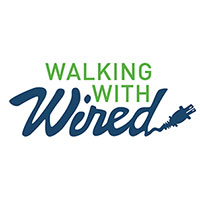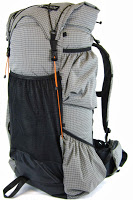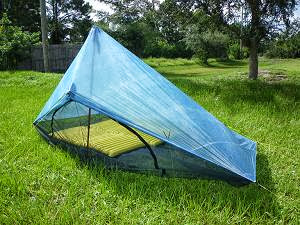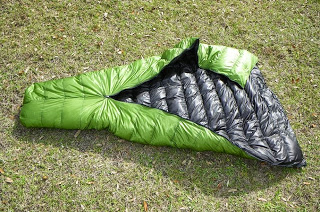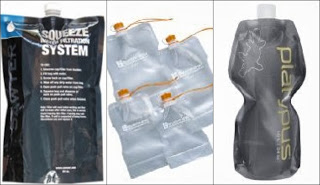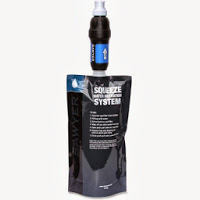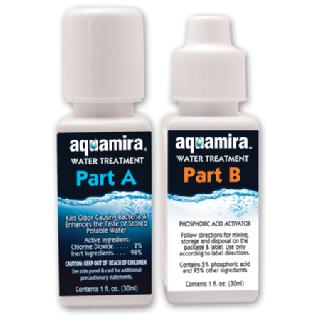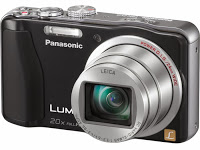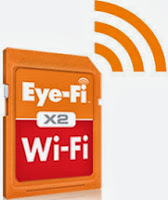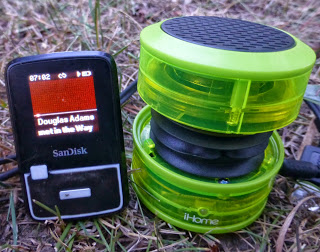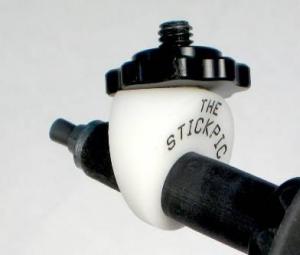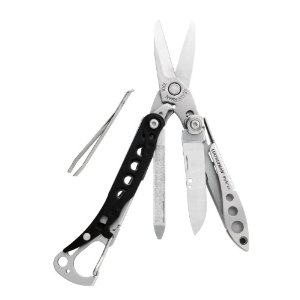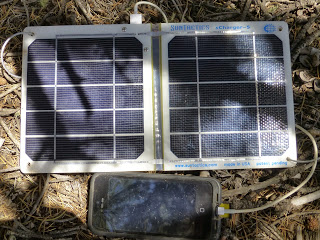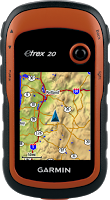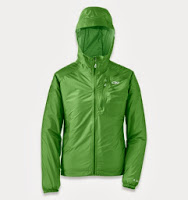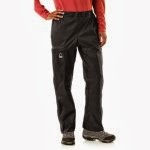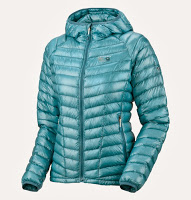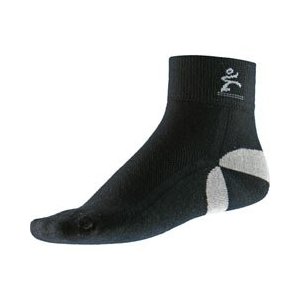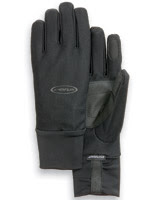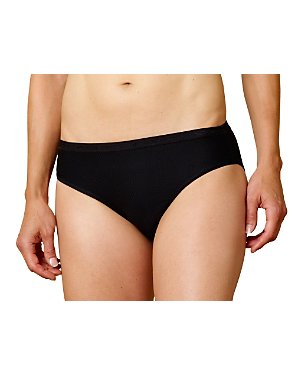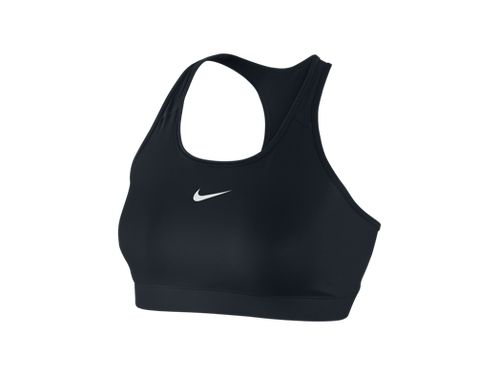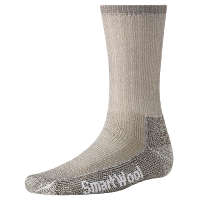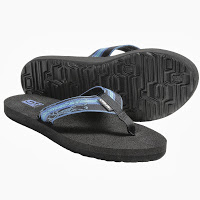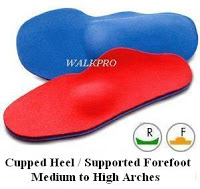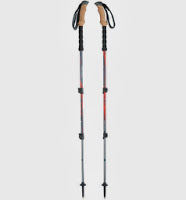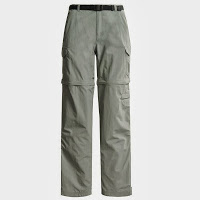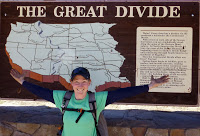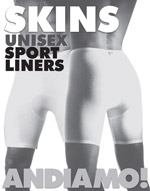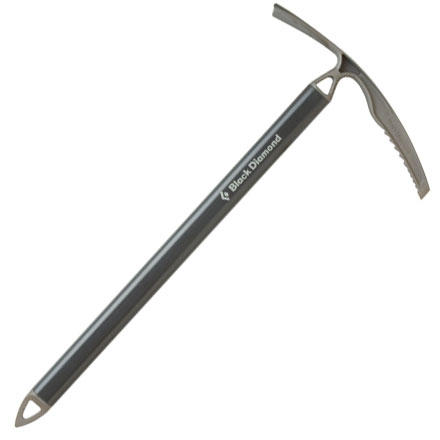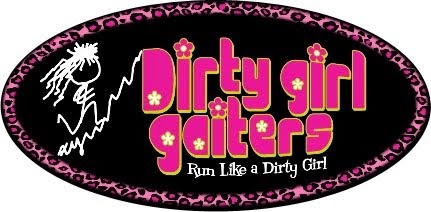preferences are a very personal thing and that everyone needs to find what fits
them the best. Just because I use it doesn’t mean it’s guaranteed to work for others. There’s a great variety out there and this is what has worked for me.
Gossamer Gear Mariposa(1lb, 9.8oz)
Pros: This pack is perfect for me! The only pack I’ve ever had that didn’t give me pain when it was fully loaded. I realize this may also be due to the fact that I lightened my pack load, but there were times I didn’t even feel like I was wearing a pack! I also had no problem carrying my full water capacity of 4.5L when necessary. I like the variety in pockets and pouches of different sizes. There were multiple ways I could organize my gear/food/water as my weight and quantities changed over a leg. An added bonus is that the back pad can easily be removed and used as a sit pad or extension to my sleeping pad.
ZPacks Hexamid Solo-Plus (1lb, 2.6oz)
Pros: Light and spacious. Took some getting used to, but grew on me more over time. For me, it held up well in inclement weather. It helps to setup in a sheltered spot, but I was in multiple thunderstorms/hail storms and it did great. I loved that the cuben fiber didn’t stretch or sag like silnylon tents do, so I didn’t have to readjust the tautness throughout the night. I liked the large side entry door and the way the tent could adjust slightly to match the elements or terrain. I got the extended beak and really liked that added protection. Getting the plus gave me the space I wanted too. One pretty cool thing is that the floor can be unattached and packed separately. I would pitch it in a storm a few hours before camp and when the rain let up, I could separate the floor and pack it dry into my bag so the rest of the tent didn’t soak it…then I’d have a dry tent floor when I pitched the tent a few hours later…makes me think I’ll be using it this way a lot on the Appalachian Trail…
Bottom Line: I will probably use this tent on the AT for its protection against rain, but my tent of choice for weekend backpacking is probably still my Tarptent Contrail.
ZPacks 10 Degree Down Sleeping Bag (1lb, 3.8oz)
Pros:Oh man, I didn’t think it could get any better than my Marmot Helium bag and then I found this baby! It is sooo warm and puffy. Very light and small. It is so warm that I was able to eliminate my sleeping bag liner and save even more weight. I was warm enough using my down jacket hood, beanie, or buff for my head, but if I had to, I was short enough to cinch it around my head easily. It is very warm and I often would just use it as a blanket and lie directly on my sleeping pad. It was nice as a claustrophobic person to feel less restricted and still be warm. Just heavenly!
Therm-a-Rest NeoAir XLite Women’s Sleeping Pad
Pros: Quite possibly my favorite piece of gear! Allowed me sink into the comfort of a bed every night. Light and compact. I upgraded to the XLite Women’s because it is lighter, shorter, and tapered so I had more room in my tent. Also, there is a reflective layer withing the pad that reflects body warmth back to the person laying on it. Really amazingly warm!
Caldera Cone Stove Set
Pros: Light, efficient, simple, and sturdy. I’m a big fan of this setup and also used it on the PCT.
simmer setting, so care is needed for doing more than boiling water. Hard
plastic container can take up space, but I used the top as a cup. The base of
the container gets way too dirty/sooty to use as a bowl as advertised. I bought a larger bottle to hold fuel for longer legs, but it still fit in the container. Sometimes the fuel would leak a bit in the casing and it just air dries when I open it.
Evernew Titanium Pot (.9L)
Bottom Line: Nothing will last a whole hike, but go with the Platys or Evernews for best lifespan.
Sawyer Squeeze Water Filter
water and another 20-30mins before drinking. Somehow I always squish or bang the little bottles enough to cause one to leak and leave a bleach mark (or even hole!) in my pack.
hold Clorox bleach to save time/effort (two drops/liter and wait 30mins).
Panasonic Lumix DMC ZS19
Pros: A great wide angle that captured more than any other camera I’ve ever had. Great quality video. Sturdy shutter over the lens that is less likely to get dented or stuck opening/shutting with the bumps of a thru hike. I loved the powerful zoom that also worked in video mode. Also, loved the ease with which I could take panoramic shots.
Eye-Fi SD Wi-Fi Card
Pros: Nifty little SD card that gives me the ability to transfer my pictures from my camera to my iPhone for blogging or sending out pictures.
Cons: This particular card would load ALL my pictures from the day, but I found out (from a blog follower below!) that you can set it to transfer selected photos. Here is the link to load select photos on an Eye-Fi Card. I heard other SD cards (EZ Share) let you choose individual photos and some cameras now have this function built into it.
SanDisk Sansa Clip MP3 Player
Pros: One of my favorite pieces of gear! It would greatly impact my hike if I didn’t have this little guy. Held all my songs and
audiobooks easily. Also, small and clips to clothes or pack for easy
use. Plus, it plays and records radio! Even takes mini sd cards so people were able to send me more songs and audiobooks.
Cons: Doesn’t hold as many songs as more expensive players unless you buy a mini sd to put in it.
iHome Speaker
Pro: My luxury item for Montana. This tiny speaker plugs right into my phone or MP3 Player and plays it out load in great clarity. Great for two reasons. One was to warn bears that I was coming. The other was to listen to music and audiobooks aloud with fellow hikers. Another big plus is that it came in my “wired green” color! Lots of fun:)
Con: Added weight that really isn’t necessary. I wouldn’t recommend carrying it the whole hike…maybe just NM(if you are with a partner) and MT(for the bears).
StickPic
I had a lot of people ask how I shot my videos while I was walking. I
used the awesome StickPic. It allows you to attach your camera to the
end of your hiking pole for both pictures and video. Love it! You can order it online.
Careful, they are easy to lose, so I recommend putting it on a
carabeener. Also, if you lose the nut that tightens it to your camera,
you can use medical tape on the screw and it tightens just fine.
Sea to Summit
Ultra Sil Dry Sacks
Pros: My sacks have lasted me three years and two complete thru hikes. They come in various sizes and colors for organizing small
things. Light, resilient, and water resistant. Those who used Cuban fiber sacks
had difficulty with them shredding apart.
one I had drove me nuts at night and in the early morning because I always had
trouble finding it in my tent or pack.
iPhone5 (with LifeProof Case)
Pros: Amazing! Service is best with Verizon. It was my own personal computer, phone,
camera, alarm clock, and GPS all in one. Quick and easy panoramic shots and I really liked how vivid some of the
scenic pictures were too. Good video when my real camera wasn’t working. I loved being able to Skype or FaceTime family or friends. Of course watching TV in my tent is a great plus! Just amazing, love it!
keep it in airplane mode whenever possible. I wouldn’t use it as my primary camera or video recorder, but it works great if you are looking for an all-in-one option.
always protected. It says it’s waterproof, but I never fully submerged it for an extended period of time. Totally worth carrying!
I’ve always had and I haven’t had a need to replace it. I’d recommend something lighter.
MSR Packtowel Nano
SPOT-Personal Locator Device
basis. I know of hikers who had to use theirs to get emergency help from Search
and Rescue, and it works. The customer service is very attentive and helpful.
Sea to Summit Insect Shield Head Net
net…trust me! Using a fully brimmed hat is the most effective. My neck and ears
were covered in bites until I started using my buff to cover them. I hardly used it the whole CDT, but was very happy to carry it the whole way just in case!
 iFlash 4 USB Quad Port Charger
iFlash 4 USB Quad Port Charger
Pros: Allowed me to charge four different things at the same time from one outlet.
Cons: Added weight and took up space in my pack. Didn’t charge as fast as directly plugging one USB into a socket because it splits the charge.
Bottom Line: Great to have on the CDT! Can’t tell you how many times other hikers used it. There are just limited sockets in those small towns.
Leatherman Style CS Multitool
Pros: Small, light, has multiple tools (including
scissors!), and has a carabeener to clip it to my bag for easy access.
just adds extra weight…but those were the same hikers who borrowed mine many times!
Suntactics sCharger-5 Solar Charger
Pros: Gave me pretty unlimited power when in direct sunlight. Was like plugging my devices directly into the wall! Pretty sturdy.
Cons: Pricey. You could charge smaller things like an MP3 in intermittent sunlight or overcast, but not an iPhone. The iPhone needed direct sunlight for extended periods of time. If I was going in and out of sun, it would be draining the phone battery instead of charging it.
Bottom Line: Best option out there for more sun exposed trails. Perfect for the CDT! I’d say Good for the first half of the PCT and then maybe consider an independent rechargeable battery.
Garmin eTrex 20 GPS
Pros: A reliable GPS that worked and had a very long battery life of 35hrs or something like that…I also think it’s the lightest option out there today that gets the job done.
Cons: A pain to learn, but simple once you get it. Also, a pain to load the maps/waypoints. I give a tutorial here. It generally took about 30sec to load if I was using it frequently. If I hadn’t turned it on recently, it could take multiple minutes to load and get oriented. With this version, you have to be moving fort the arrow to point where you’re standing. I believe the eTrex 30 will orient as you spin in one place.
Bottom Line: I was glad I had it and used it more than my phone’s GPS just to save phone battery because I used it often.
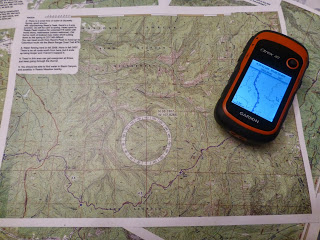
Johnathan Ley Maps
Pros: Great to have paper maps with alternates and little notes updated each year from current hikers.
Cons: Took some getting used to with red and purple likes everywhere. I still don’t get it, but apparently, the trail should be in red and the alternates are in purple…the thing is that there is so much changing that sometimes the red was the alternate and the purple was the official…either way it was nice to have options. The scale of the maps is so large that they do not provide much detail. More of a general direction to head.
Bottom Line: I rarely used them during the day and would scan them at night/morning for important notes/info. Then use my GPS and mostly the Bear Creek Waypoints. Some used these as their sole maps and loved them. Pretty impressive considering J Ley hiked the CDT in 2001 and has updated the maps through hikers and Bear Creek updates each year.
Bear Creek Waypoints/Maps
Pros: I chose not to carry the Bear Creek maps (created by Jerry Brown) because I felt one set of maps was enough to carry and the waypoints on my GPS would be enough. I LOVED having waypoints for the trail since I am directionally challenged. It is very kind of Jerry Brown to offer them for free.
Cons: The paper maps are nice, but pricey. They don’t include external notes/details like J Ley’s maps have. They also don’t have the alternates, but this winter, Jerry Brown is adding many of the main alternates to the maps! The Bear Creek maps are much clearer to read for actual navigation.
Bottom Line: I recommend saving money by getting J Ley’s maps (which also has helpful notes and fun alternates/side trips) and then loading the Bear Creek waypoints on your GPS…but be sure to donate for those waypoints! Some people chose to carry both sets of maps. Some people only carried Bear Creek and added J Ley notes to them in pencil before the hike…all a matter of personal preference.
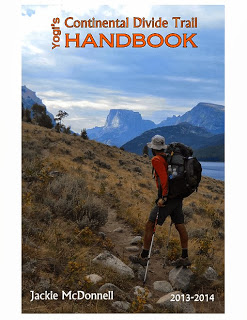 Yogi’s CDT Handbook
Yogi’s CDT Handbook
Pros: The
details in trail towns change often and Yogi does a good job of keeping things
as up to date as possible. Every year, there are a ton of questions
asked on the CDT-L about preparation, mail drops, trail towns, etc. My biggest confusion was all the routes and where it splits and that’s all in there. Some hikers (and I’m not saying I’m one of them) found it very useful to
have a digital scanned copy of the Town Guide on their phone. Those
people were able to look ahead to any town to help with planning and
decision making while others had theirs boxed up in future resupply
boxes. Yogi clearly says it is not legal to do such a thing, so I’m not
saying I did that…just that hikers who did found it very
convenient…those rebels!
have the handbook to successfully hike the trail, but it will make the
experience much more enjoyable.
Beacon’s CDT Data Book
Pros: Ah-mazing! It was so nice to have this quick cheat sheet to glance at the day ahead of me. beacon basically took all the Bear Creek waypoints and water sources and listed them in order along with mileage differences, elevations of each waypoint, and what map they correlate with on the J Ley maps.
Cons: Not all inclusive. Missing many water sources listed on the J Ley maps and also does not include the alternates. I’m talking with Beacon to see if he is updating this for next season…I’ll keep people posted as all these maps are always evolving.
Bottom Line: Get it if it still matches the waypoints for 2014…TBD…
because it has no vents. Also, to save weight, there are no side pockets. I used it almost every morning as my wind breaking jacket until I warmed up. By the time I got to the end of the trail, I had worn through it on the shoulders and hips and didn’t expect it to be full waterproof, which it wasn’t. It did get me through steady rain many times just fine…but not perfect.
find yourself finishing closer to October, I recommend sending yourself a warmer
jacket in MT or waterproof it again before you hit the northern rain. For the AT, where rain is almost daily, I’m getting a much heavier rain jacket.
zippers at the ankle got stuck with mud in them.
Mountain Hardware Ghost Whisperer Jacket
Pros: Small, light, compact, warm, resilient, awesome! I think it is still the lightest down jacket on the market. Made for a great pillow at night too!
I get cold easily, but many hikers saved the weight without the hood.
Balega Socks
I loved these socks. They are just basic running socks. My feet had bad reactions to wool and
these were great. They would generally last three legs or more depending on the terrain/distance.
so I suggest getting a pack of latex gloves to wear over the gloves in the rain
or in the mornings when taking down a wet tent. The latex ones lasted a long
time, but I threw a new set in each resupply just in case. A simple thing that
made my days so much more enjoyable!
and I had a third for sleeping.
Diva Cup-Feminine Hygiene
Okay ladies, just like you, I worried about how I’d handle
my monthly period on the trail. If you have to deal with it, then I suggest the
Diva Cup. Look it up. I would definitely practice using it before going on the
trail if you’ve never used it before. I like it because it’s minimal, I don’t
have to worry about accumulating trash, and depending on the day, I could go
the whole day without having to worry about it. I love that it is
environmentally better AND saves me money. I have converted to using it in
everyday life and I really recommend it.
doubles as a great swim top.
Teva Mush II Thong Sandals
backpacking if I didn’t have dry clean sandals to put on at the end of the day
and middle of the night for bathroom runs. I saved a lot of weight switching to these from Crocs and they were super comfy!
Cons: Wearing them with socks is a pain. I usually just slipped all my toes to the side of the thong when I needed to walk at camp.
Montrail AT Plus Hiking Shoes
Lynco L405 Sports Orthotic Insoles
I knew I’d need some type of added support to hike the trail and another
hiker told me about the Lynco Insoles. I am a neutral walker and tend
to need something for the ball of my foot. These are very unique and I
recommend using them for a good month before the trail if your feet are
new to them. They have a lump under the upper part of the arch of your
foot. There are other styles for different needs. The unique form takes
some getting used to, but I found them to feel great and also relieve a
lot of the pressure on the ball of my foot. Totally worth the price for
me. I bought a new pair with each pair of shoes. Many people bought
insoles more/less often than that though. It’s a matter of personal preference.
they worked out great. I like the ergonomic cork handles and flick locks. I didn’t have to replace the tips all trail! Also used one as my main pole to support my tent and they were great! There are pricier versions of these made of carbon. Mine were aluminum.
made it through the whole trail. It was nice to have the option of shorts or
pants. They have lots of pockets for my gadgets and snacks. The only pants I
could find that weren’t form fitting and tight in the thighs. I wish they came
in XS because they ran a bit big in the waist for me and became very loose toward the end of the hike.
Patagonia & Brooks Shirts
I was determined to find my green/navy combo again and came up with these two polyester meshy shirts. A navy long sleeved running tech Brooks shirt I ordered from my local running store…and LoveNote found me the greet Patagonia shirt. Both did great! The lighter colors show sweat stains.
Smartwool Microweight Pajama Top/Bottom
It took me forever to buy these pricey pajamas, but they were perfect and saved me many ounces off what I was using before. The pants are slightly sheer and I’d only wear them in my tent. Sometimes they were surprisingly too warm and I wouldn’t wear them. Both could be used in emergency for extra warmth. I used the top once as a base layer in a cold unrelenting rain and it worked!
bought two pairs and only needed one the whole trail. They were also great to
wear for swimming. A suggestion from the maker is that if they are being used
for hiking, cut off the tight elastic band on the thighs. Worked great for me!
I recommend buying two pairs and switching in N Cal. I once tried to go a week
without them and I couldn’t stand all the debris that got in my shoes. Also,
without them, my socks were quick to get holes in them.
Some hikers used the C.A.M.P Corsa or Whippet to save weight, but it’s all up
to personal preference and how much security you feel you’re comfortable with.
As for length, I personally feel like longer is better. I like to have something I can plant into the snow on long traverses and if it is too short, I find myself bending over and off balance. There is no point in saving on weight
if it negates the point of having an ice axe to begin with. It is used to self arrest if a fall occurs, but also helpful for support along a traverse. Everyone has their own preference of what works well for them.
